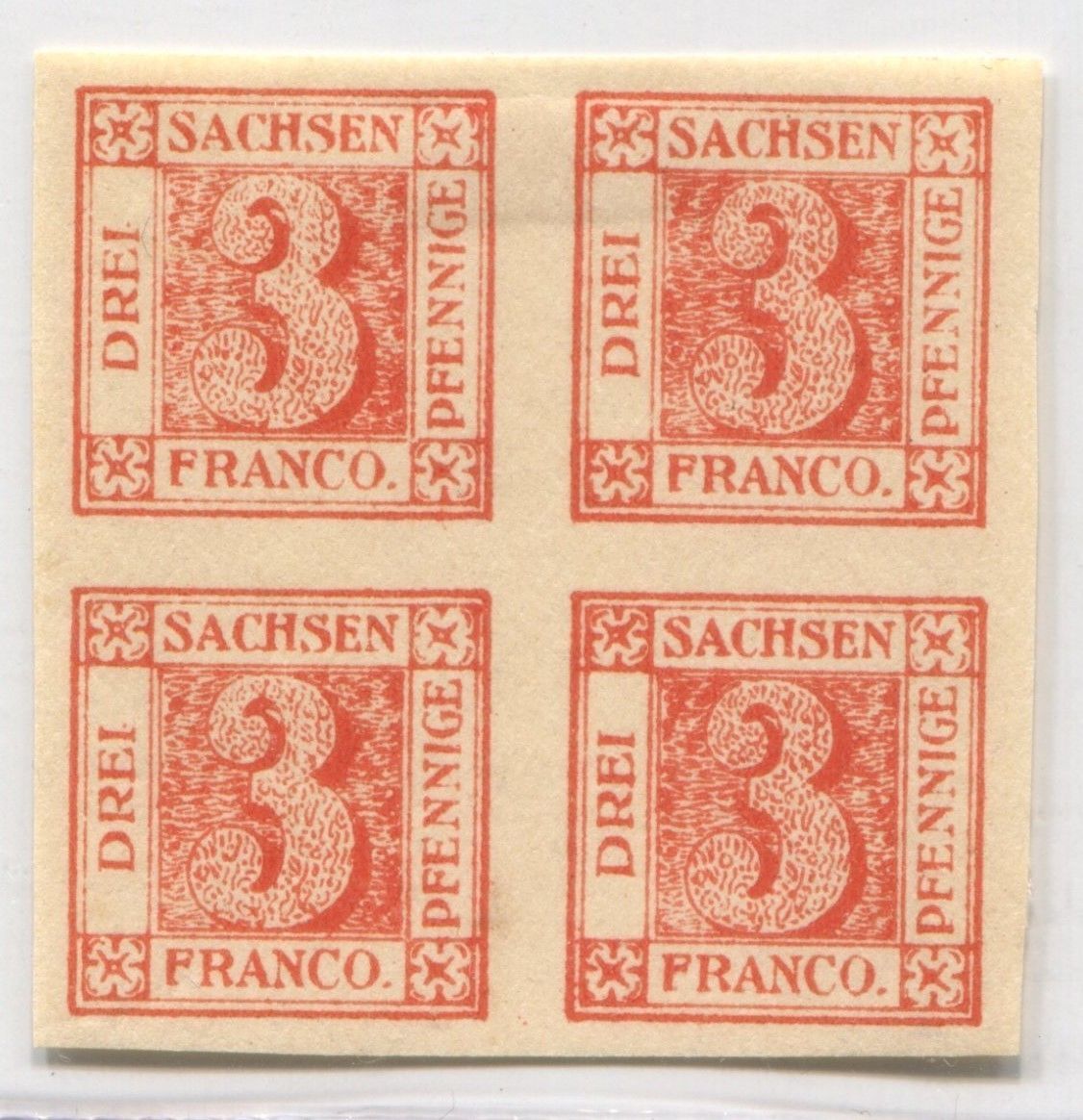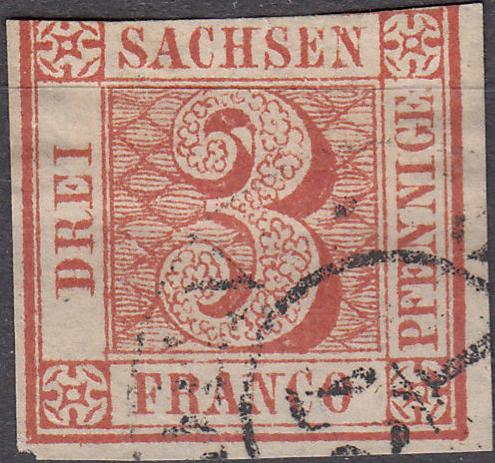 |
|||||
|
|||||
| Preview of Stamps Catalogue: VOLUME 1 |
 |
|||||
|
|||||
| Preview of Stamps Catalogue: VOLUME 1 |
Return To Catalogue - Saxony forgeries of the first issue, part 2 - part 3 - Sperati forgeries - Peter Winter forgeries - Saxony first two issues - Saxony other issues 1851 onwards - Other German States - Germany
Note: on my website many of the
pictures can not be seen! They are of course present in the catalogue;
contact me if you want to purchase it.
Genuine stamps:
Attention: many forgeries exist of this stamp. The great majority of stamps, that I have seen were forgeries! In the genuine stamps, the rosettes in the corners have only three shade lines in it, except for the upper left one, which has four shade lines. There is an opening in the line at the left side of the "I" of "DREI". There should be NO opening in this line next to the "R" of "DREI". There should be a dot behind "FRANCO". Forgers that are known to have made forgeries of this stamp (or at least were involved in marketing them) are: Ferdinand Elb, Engelhardt Fohl, Francois Fournier, Julius Goldner, Hirschfeld (the printer of the original stamps!), Oswald Schroeder, the Senf brothers, Jean de Sperati, Thiele, Peter Winter, Zechmeyer. In the 'Praktisches Handbuch der Freimarken des Konigreichs Sachsen' by Friedrich W.Dieck (1921) it is stated that the earliest forgeries were made by Zechmeyer in the 1850's. In the 1880's rather deceptive forgeries were made in Dresden by Elb and Fohl, they were cancelled with a grille cancel that rarely appears on genuine stamps.
Hirschfeld 'reprints'
According to https://www.stampsx.com/ratgeber/ratgeber-sachsen.php this forgery is not very well done. It has a very 'smeared washed out' appearance.

Whole sheet of Hirschfeld reprints. Stamp #10 (second stamp in
the last row is illustrated in the Sachsen Ratgeber:
https://www.stampsx.com/ratgeber/ratgeber-sachsen.php, there is a
white area above the "A" of "FRANCO")

Is this a reprint of the Ferrary block?

Forgery with cancel "XI. DEUTSCHER PHILATELISTENTAG DRESDEN
23 JULI 1899". This might be a Hirschfeld reprint, although
I don't see where this particular reprint fits in the above
sheet.
Goldner(?) forgery:
Forgery of The Spud Papers (also first forgery of Album Weeds), one of the most common classical forgeries:

(Reduced size)

(Could these be the forgeries described in 'The Spud Papers'?)

This forgery sold with some other stamps of Saxony for 1110 Euros
on Ebay (2008)!
Some forgeries are described in 'The Spud Papers': these forgeries have the outer frame line very thin (same thickness as the inner frame line). The "C" of "FRANCO" is smaller than the other letters of the same word. There are no shadelines at all in the rozettes in the corners. I have seen these forgeries being offered as genuine on E-bay! This forgery is also listed as first forgery in Album Weeds. It is the most common forgery. I've been told it was made by the forger Goldner, but I'm not sure if this information is correct. Many different cancels seem to exist on these forgeries.
Senf forgery:
In the above forgeries, the "R" of "DREI" has an upgoing tail and the "D" has a very long bottom stroke. Also note that the upper stroke of the "C" of "SACHSEN" almost touches its lower stroke. The second stamp has an overprint "FALSCH." (meaning forged in German). I've seen this forgery quite often. It was made by the Senf brothers. The Senf forgery often has the word "FALSCH" erased or cancelled over. The same image appears on an advertisement for a Schaubek album (in 1876 Louis Senf bought the rights of the Schaubek catalogue). .

This looks like a blurred version of the Senf forgery with very
large margins.




Forgeries: all four rosettes have FOUR shadelines, the third
stamp with the "PLAUEN" cancel was sold for 400 US$ in
a prestiguous Internet auction..... On
https://www.stampsx.com/ratgeber/ratgeber-sachsen.php it is shown
with a "DRESDEN 7 Mai 50" in a double circle with empty
center.




Four shadelines in all four rosettes. Furthermore the lettering
is very badly done in this forgery. For example the second
"S" in "SACHSEN" or the "O" in
"FRANCO". The margins are too large. In the genuine
stamps, the large "3" is filled up with many very small
"3"s, here these are replaced by lines and even a
circle.

(Upper rosettes have 4 shadelines, bottom ones only 3)







(in the first forgery three rosettes have four shadelines, the
other forgeries appears to have been made by the same forger;
there is not dot behind "FRANCO"). Note the cancel
"DRESDEN 27 1" that appears on several of the above
forgeries.



In this forgery there is a dot behind "PFENNIGE". It is
printed quite blur. The centre of the upper left ornament is
placed too far to the left. The word "FRANCO" is too
big.

Forgery with different flower pattner in the corners and the
lettering badly done (see for example the "R" of
"FRANCO").
Other forgery:

A dangerous old forgery. The genuine stamps always have the upper
right flower design connected by a small white line to the white
space below it. This is lacking in this forgery.

A whole sheet with forgeries and forged "HAYNICHEN 30 VI 7
65." cancels (the same cancel that also appears on Peter
Winter forgeries). In these forgeries, there is a red line all
across the upper left part of the large "3" (see also:
https://www.stampsx.com/ratgeber/ratgeber-sachsen.php)


These forgeries seem to be the same, or at least inspired by the above "Tag der Briefmarke 1979" commemorative sheetlets, which exist in red and black. Despite the text at the bottom "Der einzige erhalten gebliebene Sachsendreier-Originalbogen", this is not an exact reproduction of the only surviving sheet of 20 stamps.... Just look at the separating lines which are all continuous in the above sheetlets.

I think this is the modern forgery shown on
https://www.stampsx.com/ratgeber/ratgeber-sachsen.php. The wavy
background pattern is different from genuine stamps. It is said
there that it was printed with a laserprinter, but it doesn't
look like it.
Saxony forgeries of the first issue, part 2 or part 3